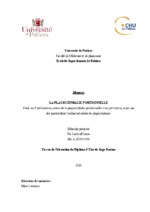Mémoire
Lascaud Laura
La plagiocéphalie positionnelle : étude sur l’information, autour de la plagiocéphalie positionnelle et sa prévention, reçue par des parents dont l’enfant est atteint de plagiocéphalie
FrançaisConsulter le texte intégral (format PDF)

Résumé
Français
La plagiocéphalie positionnelle : étude sur l’information, autour de la plagiocéphalie positionnelle et sa prévention, reçue par des parents dont l’enfant est atteint de plagiocéphalie
Introduction : Il est observé depuis la campagne ayant pour objectif de prévenir la mort subite du nourrisson en 1992 une hausse de l’incidence des cas de plagiocéphalie positionnelle, alors qu’un certain nombre de conseils de prévention existe pour éviter son apparition. Nous nous sommes alors demandé si les parents recevaient des informations sur la plagiocéphalie positionnelle et sa prévention et si ces conseils étaient facilement applicables.
Matériel et méthodes : Un questionnaire a été distribué, dans un cabinet de kinésithérapie à Poitiers, à tous les parents consultant pour une plagiocéphalie positionnelle chez leur enfant. Quarante réponses ont pu être recueillies.
Résultats : Vingt-deux couples soit 55% avaient déjà entendu parler de la plagiocéphalie avant le diagnostic de celle-ci chez leur enfant. Les couples estimaient leur niveau de connaissance à deux sur dix avant le diagnostic puis à neuf sur dix après le diagnostic de leur enfant. Vingt-neuf couples soit 72,50% auraient préféré être informés plus tôt sur la plagiocéphalie. Vingt-quatre couples soit 60% disaient être sensibilisés de recevoir des informations à propos de ce sujet, 21 soit 52,50% disaient être rassurés et un couple soit 2,50% disait être stressé. Concernant la mise en pratique des conseils de prévention, 65% ont trouvé cela facile à faire, 27,50% ont trouvé cela très facile et 10% difficile. Trente-huit couples soit 95% estimaient qu’il n’existe aucune contradiction entre les conseils de prévention de la plagiocéphalie et d’autres conseils qui pourraient être donnés pour leur enfant. Deux couples soit 5% trouvaient qu’il existait une contradiction avec les conseils de prévention de la mort subite du nourrisson.
Conclusion : Il y a encore une trop grande partie des parents qui sont peu ou pas informés sur la plagiocéphalie positionnelle et les moyens de prévention. Notre étude a été faite avant la publication de la HAS sur les déformations crâniennes, il serait intéressant de faire une autre étude à plus grande échelle pour voir si cette publication a eu un impact sur les informations données aux parents.
Mots-clés libres : plagiocéphalie positionnelle, connaissance, prévention, diagnostic, incidence, kinésithérapie.
- Plagiocéphalie positionnelle
- Crâne -- Malformations
- Kinésithérapie pour enfants
English
Introduction : It has been observed since the 1992’s campagn over babies’ sudden deaths an increase incidence of cases concerning the deformational plagiocephaly. This happened even though prevention advises were given to avoid its apparition. We then wondered if parents were receiving right informations about deformational plagiocephaly and if prevention advises were easily applicable for them.
Materials and methods : A survey has been given in a physical therapy cabinet in Poitiers, to every parents having child with a deformational plagiocephaly. Forty anwers have been gathered.
Result : Twenty two couples reprensting 55% of the sample knew about the deformational plagiocephaly before it was diagnotized to their child. Couples were evaluating their knowledge about the syndrome at 2 on the scale of 10 before the diagnosis, then to nine after the diagnosis. Twenty nine couples representing 72,50% would have preferred to be informed sooner about the syndrome. Twenty four couples representing 60% affirmed to be sensibilized about the topic. 21 couples representing 52.50% were statuating their emotion as « releived » when one couple (2.50% of the sample) was feeling stressed. Concerning the implementation of the prevention advises, 65% of the couples were evaluating the process as « easy » to respect, 27.50% as « really easy » and 10% as « hard » to respect. Thirty eight couples representing 95% of the couples estimated that there is no contradiction between prevention advices of the deformational plagiocephaly and other advices that could have been given to there children. Two couples representing 5% of the sample were thinking there was a contradiction with advices given on infants’ sudden death.
Conclusion There is still an important part of parents that are uninformed or under informed about the deformational plagiocephaly and it means of preventions. Our research has been done before the publication of the HAS on skulls deformations, it would be interesting to make another research on a bigger scale to see if the publication has had an impact on informations given to the parents.
Notice
- Diplôme :
- Diplôme état sage femme 5ème année
- Établissement de soutenance :
- Université de Poitiers
- UFR, institut ou école :
- UFR Médecine et Pharmacie
- Domaine de recherche :
- Maïeutique
- Directeur(s) du travail :
- Nathalie Le Leizour
- Date de soutenance :
- 24 juin 2020
- Président du jury :
- Julia Deparis
- Membres du jury :
- Nathalie Le Leizour, Cyndie Laubreton, Vanessa Poupard
Menu :
-
-
à propos d'UPétille
-
Voir aussi
Annexe :

-
Une question ?
Avec le service Ubib.fr, posez votre question par chat à un bibliothécaire dans la fenêtre ci-dessous ou par messagerie électronique 7j/7 - 24h/24h, une réponse vous sera adressée sous 48h.
Accédez au formulaire...
Université de Poitiers - 15, rue de l'Hôtel Dieu - 86034 POITIERS Cedex - France - Tél : (33) (0)5 49 45 30 00 - Fax : (33) (0)5 49 45 30 50
petille@support.univ-poitiers.fr -
Crédits et mentions légales
